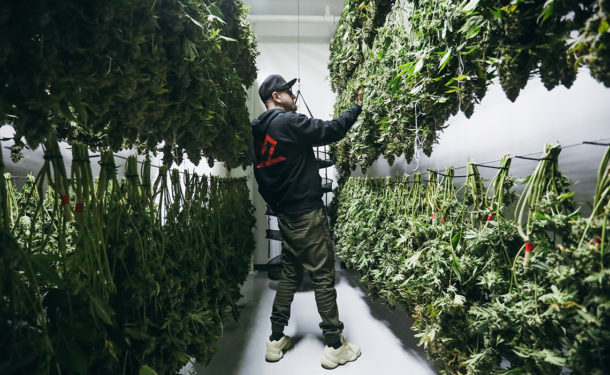System Of A Down Co-founder Is Now Marijuana Cultivator
A historic jazz scene emerged on Central Avenue in Los Angeles at the dawn of Prohibition, and jazz music played an early role in popularizing cannabis in North America. A century later, music and cannabis come together again a few blocks from the Prohibition-era scene as a Grammy-winning music artist meets with one of the growers behind his fast-rising cannabis brand.
Shavo Odadjian has a new primary passion in 22Red. The System of a Down co-founder launched the lifestyle brand last year, and while he doesn’t limit himself to just one grow, he chose The Originals from the Kush Valley Collective when PRØHBTD sat down with him and one of his growers to discuss 22Red. Odadjian had visited the space many times before, yet his energy and excitement remained high as The Originals’ grower, who asked not to be named, walked us past rows of gorgeous plants at various stages of development.
Odadjian has already made an indelible mark on music, and like the jazz scene birthed in this very neighborhood, he’s ready to do the same with cannabis.
Shavo, what was it about these growers that made you want to work with them?
Shavo: When the idea for the brand started coming to fruition, I went to certain growers with my partner—let’s call him Mr. X because I don’t know if he wants his name out there—and this place always stood out. We tested all the OGs [at the different grows], but this spot had the gas [smell and flavor]. Once I smoked it and noticed how fresh and well curated it was, I knew this place was one of the best, and we had them exclusively grow a couple [of strains] for us.
Tell me about your grow and what makes it stand out.
Grower: There are two types of growers: the scientist and the artist. Each grower has an element of both, but they are typically dominant in one or the other. I never thought of myself as an artist, but we definitely take pride in what we do. We’re like a family, literally a family. We grow the same strains with the same regimens as other [places], but each grow is different in some way. It has to do with the head of cultivation and trickles down to the maintenance department. It’s care, it’s love.
Shavo: It’s a positive atmosphere, and the plants react to that in the same way they react to music or to talking. When there’s good energy around them, the plants get good energy. I totally believe it, man.
When you first started talking, do you remember what you said you were looking for?
Shavo: I never told anyone specifics. I just pick and choose, and then they go in that direction. They do our OG, and the OG is so amazing that now we’re moving into different strains and flavors and exotics. I have to go through all their rooms and maybe test some [plants]. He gave me about eight different flavors last week, and a few stand out. That gelato is fire.
Grower: Shavo is looking for the best of the best. He’s looking for connoisseur grade—high-end cannabis that’s hard to grow and that you’re not going to find everywhere. You’re not going to find these strains at this quality, at this level, in many shops. I know that’s what Shavo was looking for because that’s why he chose us. We have a library of genetics, and we’re more than happy to pull out the library and bring some strains in, but OG Kush is in very high demand, and that’s our specialty.
Tell me about some of the plants you’re growing specifically for Shavo.
Grower: We’re growing the 22, which is OG Kush.
Shavo: They have a mimosa coming up that I might be digging. We have a mimosa now [from another grower], but we might be moving depending on how this one comes out.
What are some specific qualities of the plants that these growers do best?
Shavo: [I would say] the gas smell, the aromas, especially in the OG rooms. The high is really level yet strong. I don’t get anxious when I smoke this OG. Other OGs out there might make you paranoid because the sativa level is a little too high, but here you don’t feel too high or too low even though you’re still high as hell. You open the jar and, connoisseur or not, you’ll say, “That’s the shit.”
Grower: People are spraying stuff on the plants—it could be all natural and whatnot—but if you do that at the wrong times, you mess with the structure and the look of the flower. It’s the same thing with your maintenance, your trimming, your packaging. At all these different levels and stages of the plant, you can ruin the look. Maybe it’s going to test the same, smoke the same, smell the same, but it’s not going to look the same, and a lot of it is visual. You want that visual, you want your herb to be perfect.
Shavo: The same goes for quality. I’ve seen flowers that look godly and then there’s nothing in them. There’s no substance whatsoever. No flavor, no taste. I won’t name from where but… the flower looks great in Instagram pictures, but there’s no stickiness.
Grower: Trichomes. With [our grow], you touch it, and you have to wash your hands with some extra heavy duty soap. Plenty of strains turn purple, but it needs to have density, it needs to have THC, it needs to touch all the bases.
Shavo: Outside of OG, some of the flavors I personally enjoy have lower THC levels—they’re maybe in the mid or lower 20s [as a percentage of dry weight]. Those are all-day smokes for when you don’t want to be hammered to the floor. I like to be stoned and still able to work, and that’s where we’re going with these other flavors. I’m also looking for a really good Jack…
Grower: We have an awesome Jack. That’s the ultimate daytime strain.
Shavo: I always wanted to mix a Jack and an OG because I love to mix strains. I used to do the whole speedball thing packing a Jack and an OG, and you’re right in the middle. Nowadays, you can make that happen in one hit. The Lemon OG has that vibe a little bit.
Grower: We’re going to make the Lemon OG work because it’s so exotic and so beautiful. It’s difficult to grow, so growers want to stay away from it, but as far as cannabis…
Shavo: Why is that?
Grower: Mostly yield. It’s the same with the cookie strains, which are notoriously horrible yielders. If you have a grower that you hate, send him the greatest cookie strain because he’ll be like, “I need to grow it!” and then the yield will be so bad. Some of the strains that have the lowest yields have really good flowers. The Church, for example, has a really small yield, like we’ll go for twenty pounds and get ten.
Shavo: What about that crazy purple one we saw last week?
Grower: There were a few of them. There was Venom. The Royal Highness.
Shavo: The THC was very low on those. Those wouldn’t be ones we’d bring, but they’re still good for the everyday smoker who wants to get high but not stoned.
Grower: Like for my aunt. The Royal Highness is for her. She’s like, “Don’t give me that strong one again.”
Shavo: There are a lot of people like that. My wife doesn’t smoke, but every now and then when we’re at home and the kids are sleeping, she’s like, “Okay, let me take a hit.” No way would I give her an OG because then my night’s over. I’d have to get some Jack or something like that.
In what ways do you educate consumers on which 22Red strains might be best for them?
Shavo: I do a lot of interviews, and I do a lot of posting. I’m one with my audience, with my followers, people who like to see what we do. I give descriptions for each flavor.
Top pick for a connoisseur?
Shavo: It matters how they want to feel and what time of day they want to smoke.
Let’s say right before work.
Shavo: Right before work? Something like a Jack or Mimosa to keep you going. But at PRØHBTD? That’s different. You’ll want Green Crack.
(Laughs.)
What about for someone relatively inexperienced with cannabis?
Shavo: I would do the Church. It’s like 19 or 20 percent THC, and the aroma is one of a kind. It smells like frankincense, very pine-y, and that’s good for both the novice and the connoisseur. A novice could do the Church all day and be cool with it, and the connoisseur might want to change flavors and have a new midday high. I introduced Church to someone at my PR company, and now he won’t smoke anything else. It has a really amazing taste that coats your throat.
Are you putting limits on how many exclusive strains you’re going to drop this year?
Shavo: I don’t limit myself. When something comes up, we take it. I always want to have four or five flowers as part of our roster, but then I want to do special ones that only come out for a certain amount of time and then they’re gone and they’re not coming back.
This grow is a family-run business. How far back does the business go?
Grower: I remember putting a weed plant in my grandma’s backyard when I was 14 or 15. I walked back there with my uncle, and he’s like, “That’s not marijuana,” and then all my aunts were standing around it. I’m like, “Holy shit, what’s going on?” They pulled it out, but I’ve been interested in it since we were kids, and I always knew I wanted to do this. When it came to reality, I jumped on the chance to do it.
Tell me about your development as a grower.
Grower: Technology has played a big part, and it keeps getting better. The lights got better. We got better. Even in this facility, we’re doing things now that we weren’t doing even a year ago. With the laws and the compliance and the testing, we had to remove some stuff [from the nutrients] so that we now have a base formula that we mess with depending on which plant we’re feeding. To be able to take stuff out and still have the plants come out the way they’re coming out is just a godsend. Ninety-five percent of companies are dealing with that issue right now: Once they take something out, the marijuana is no longer the same. The structure’s not the same, the potency is not the same, and even if they had a beautiful plant before, it’s not so beautiful anymore. We’re really blessed that we did well right out of the gate.
Shavo: It’s called love. A whole lotta love.
What do you see as the positives and negatives of the state regulations?
Grower: The positive is that I don’t have to worry about anyone kicking in that door and taking my job and my livelihood. The negative is that they don’t have their shit together yet. I understand that the task in front of them is enormous, and a lot of shops are operating that shouldn’t be. They have some good people—I’m talking about the state regulatory boards, the BCC, the Department of Agriculture, the fire department—and they’re doing what they can. It seems like they’re doing a good job, but they have a lot of work to do.
What has it been like working with Shavo?
Grower: A lot of people approach us for the same thing, right? To build a brand with them. Ninety-five percent aren’t [really] behind their brand. These collabs have been done 20 times over with 20 different people, and maybe the guy will post one or two things, and then we won’t see anything about the brand for six months. Shavo is different. He lives and breathes the brand. We can see it a mile away. When he comes in here, he’s humble, and he says “what’s up” to everybody.
Shavo: Of course I do. Damn right!
Grower: I’ve had people walk through here who won’t say hi, won’t say nothing. Shavo comes in and waves to everyone, and my crew gets really excited to do collabs like this with people we look up to and who really want to do it. We want our flower to be in the right hands. Shavo was the right fit for this family here.
Shavo: I do feel like family here, by the way.
Grower: Shavo knows our family dynamic, he’s knows we’re a family-run business, he knows everything about us. We come here and work hard. It can be easy to get in the same old routine, but when something like this comes along, it’s exciting. It’s fun to see Shavo come in and to know we’re building this brand together. It just feels like we’re adding family, which I know we are.
Photo credits: Elena Kulikova.




